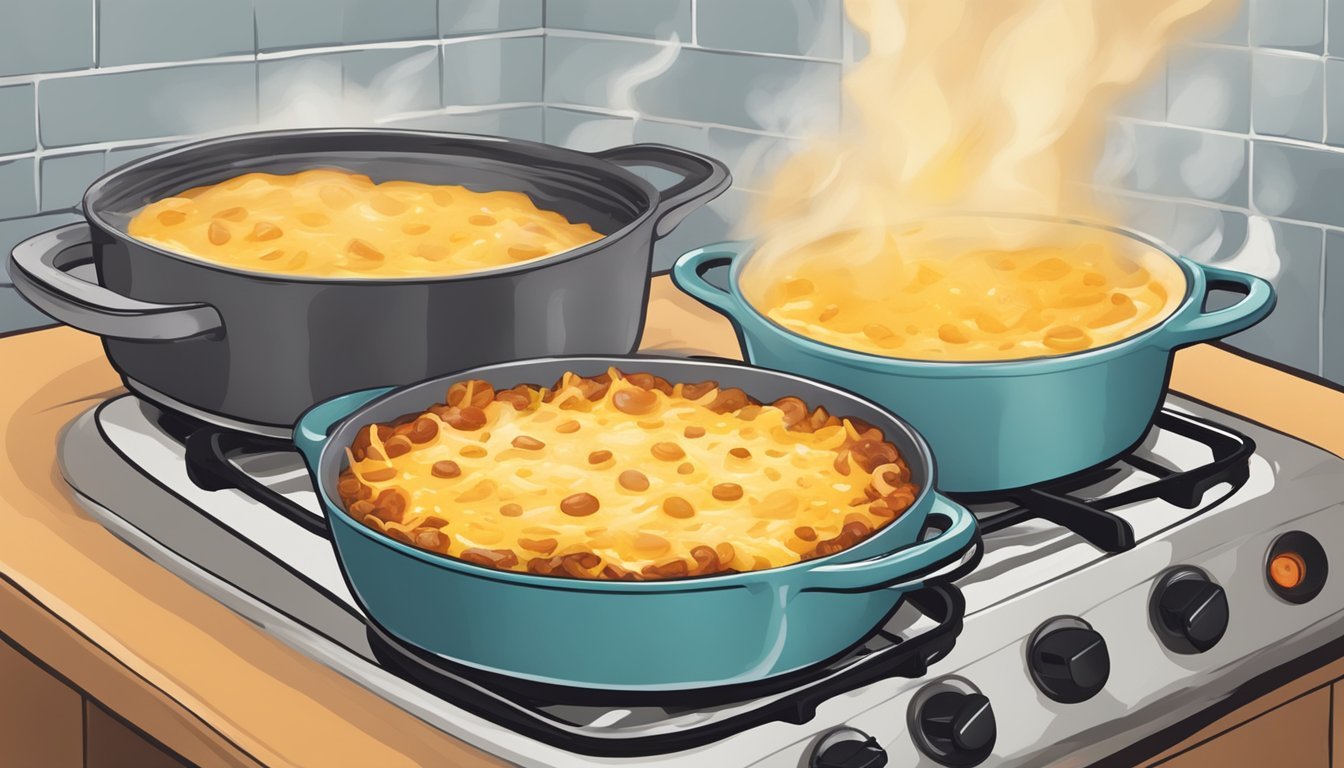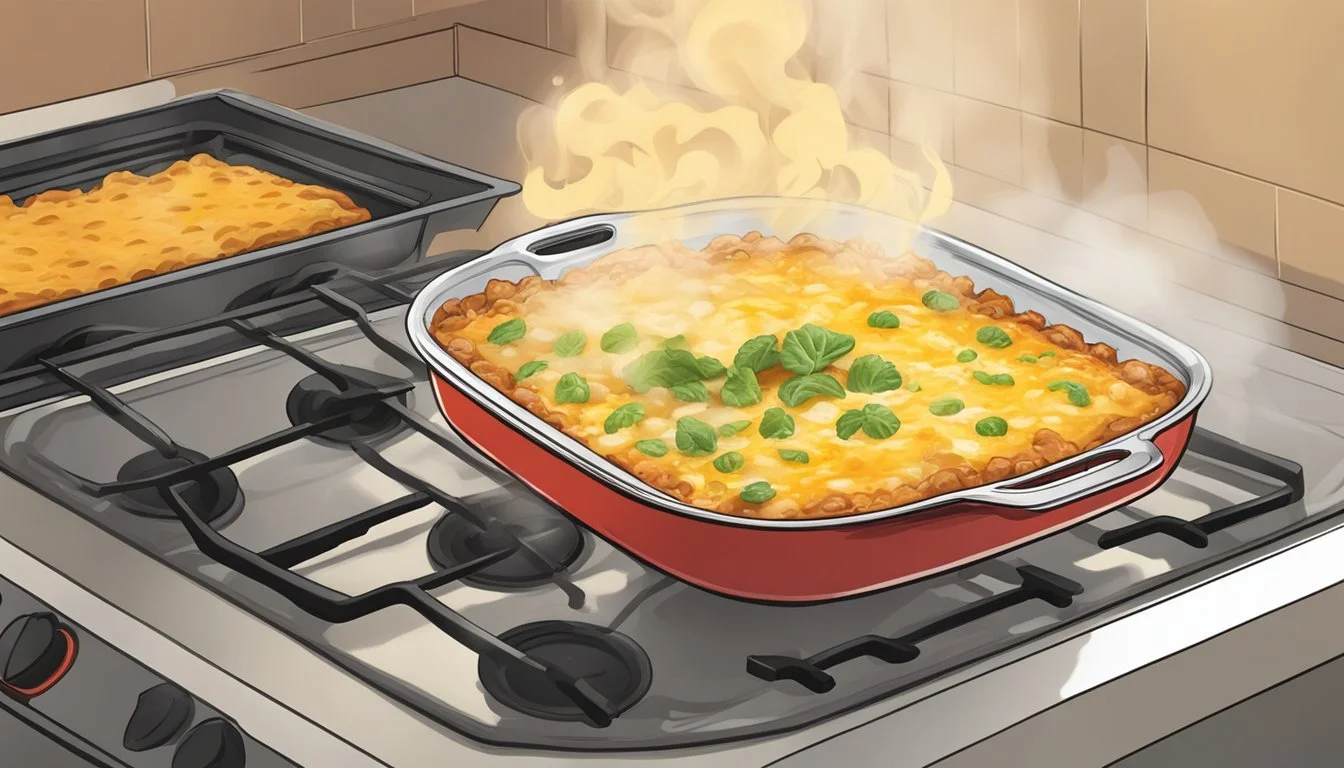Best Way to Reheat Enchilada Casserole
Retain Cheesy Gooeyness with These Tips
Reheating a dish like enchilada casserole, which is cherished for its layers of saucy, cheesy goodness, requires a careful approach to preserve its textures and flavors. The challenge is to maintain the delicate balance between a moist filling and a distinct, crispy top without drying it out. Understanding the intricacies of how various heating methods affect the casserole's components is crucial to achieving a result that is as close to freshly baked as possible.
For a dish that combines so many elements—tortillas, sauces, cheeses, and fillings—the method of reheating needs to be just as multifaceted. Ovens are commonly recommended because they provide an even distribution of heat that helps to maintain the quality of the casserole. Patience is key, as a gradual return to temperature allows the casserole's interior to become perfectly gooey, while the exterior regains its slight crunch. Transitioning the enchilada casserole from refrigerator to kitchen counter before reheating is an equally important step in preserving its integrity, ensuring that the temperature increase doesn't shock the ingredients or cookware.
Fundamentals of Enchilada Casserole Reheating
Reheating enchilada casserole is as much about preserving its luscious cheesy texture as it is about bringing it to the right temperature. Ensuring that the enchiladas maintain their quality and do not become soggy or dry requires understanding the components and selecting an appropriate reheating method.
Reheating Overview
Reheating should bring enchilada casserole leftovers to a safe, palatable temperature without compromising their integrity. Chicken enchiladas or beef variations can be rejuvenated effectively using specific techniques to keep the filling succulent and tortillas intact.
Understanding Casserole Textures
The texture of enchilada casserole's components plays a crucial role in reheating. Tortillas are prone to sogginess, while cheeses and creams aim to remain gooey and rich. Sour cream toppings, in particular, require gentle reheating to avoid separation and curdling.
Preserving Cheesiness and Gooeyness
To maintain the casseroles (What wine goes well with casseroles?)' cheesy excellence, one must reheat them evenly and gently. The goal is to melt the cheese without causing it to separate or become greasy. Cheesiness is the heart of any enchilada dish, constituting its appealing texture and flavor.
Microwave: Best for quick reheating. Cover with a lid to trap steam and prevent drying.
Oven/Toaster Oven: Ideal for even reheating and preserving crispy edges. Cover with foil and bake at a moderate temperature until heated through.
Skillet: Use for individual servings to crisp the bottom and re-melt the cheese. A few drops of water can help steam and remoisten the interior.
Air Fryer: An option for achieving a crispy texture, but may risk drying out the casserole if not monitored closely.
Selecting the Right Reheating Method
The choice among reheating methods like the oven, microwave, skillet, or air fryer should account for texture preferences and serving size. Oven reheating is favorable for large quantities or achieving a uniform, bubbly top. A microwave can quickly reheat smaller servings, but with less textural control. A skillet is the go-to for reviving crispy edges, while an air fryer can provide a unique crunch—yet each method must be handled with care to avoid turning your leftovers into soggy enchiladas.
Preparation for Reheating
Proper preparation is essential to ensure that the enchilada casserole reheats evenly and maintains its cheesy and gooey texture. This section outlines the steps needed to safely prepare your enchiladas for reheating.
Ensuring Safe Storage
It's crucial to store leftover enchiladas in the refrigerator or freezer promptly to maintain freshness and prevent bacterial growth. In the refrigerator, enchiladas should be kept in an airtight container or tightly wrapped in plastic wrap, ensuring sauce and cheese remain sealed in moisture. For freezer storage, wrap the casserole dish first with parchment paper to prevent sticking, followed by aluminum foil to secure against freezer burn. Safely stored, enchiladas can not only last but also reheat more effectively.
Thawing Frozen Enchiladas
When ready to reheat frozen enchiladas, transfer them to the refrigerator for several hours or overnight to allow a gradual thaw. Thawing guarantees that the enchiladas will reheat more evenly and preserves the casserole's integrity. Never try to reheat enchiladas straight from the freezer as it can result in uneven heating and a compromised texture.
Using the Right Casserole Dish
Casserole dishes made of glass or ceramic are preferable for reheating enchiladas in the oven. They should be microwave-safe if opting for a quicker reheating method. Before reheating, cover the enchiladas with a layer of additional enchilada sauce to avoid drying out, then seal with aluminum foil to trap in moisture and heat evenly. If reheating portions in the microwave, cover them with a microwave-safe lid or vented splatter guard to prevent mess and retain gooeyness.
Reheating Techniques
To maintain the best quality of enchilada casserole—keeping the flavor, sauce, and cheese at perfect consistency—select a reheating method that suits one's time constraints and kitchen equipment. Whether using an oven, microwave, skillet, or air fryer, each method has steps for optimal results to preserve the gooey cheese and savory meaty filling within the enchiladas.
Oven Method
When reheating enchiladas in a conventional oven, preheat to 350°F (175°C). Place the enchiladas in a baking dish, optionally topping with additional sauce to prevent drying out. Cover with foil and bake for about 10-15 minutes until thoroughly heated. This gentle reheating helps retain the saucy moisture and tender cheese.
Preheat the oven to 350°F (175°C)
Cover enchiladas with foil
Bake for 10-15 minutes
Microwave Method
The microwave method offers a quick reheating solution for enchiladas. Place them in a microwave-safe dish, cover with a lid or damp paper towel to keep them moist, and heat on high for 1-2 minutes. Check to ensure it's heated through, but be cautious not to overcook as it can cause edges to harden.
Heat on high for 1-2 minutes
Use a microwave-safe dish
Cover to retain moisture
Using a Skillet
For enchiladas with a slightly crisped bottom, use the stovetop skillet method. Heat a touch of oil in a skillet over medium-high heat, place the enchiladas in for 2-4 minutes until the bottom is crispy to preference. Add a splash of water, cover with a lid to steam, and ensure even reheating.
Medium-high heat with oil
Cook for 2-4 minutes
Add water and cover to steam
Air Fryer Approach
Reheating enchiladas in an air fryer is efficient for a crispier exterior while keeping the inside succulent. Preheat the air fryer to 350°F, place enchiladas in the basket, and heat for about 5-7 minutes. This method is perfect for those who favor a firmer texture without compromising the enchilada's inner sauciness.
Preheat to 350°F
Place in air fryer basket
Heat for 5-7 minutes
Additional Tips and Tricks
To ensure enchilada casserole retains its alluring cheesiness and gooiness upon reheating, one must manage moisture, amplify flavors, and adeptly reheat accompanying sides.
Combating Moisture Loss
Sour Cream: To address moisture loss in the casserole, a dollop of sour cream can be added after reheating. This not only replenishes moisture but also adds a tangy freshness.
Aluminum Foil: When reheating, covering the casserole with aluminum foil can maintain humidity inside, keeping the casserole from drying out. Remove the foil in the last few minutes to allow the top to regain its desirable crispiness.
Enhancing Flavor Post-Reheating
Cilantro: Fresh cilantro sprinkled atop the casserole after it is heated can enhance the flavor and offer a vibrant contrast.
Enchilada Sauce: If the casserole appears dry, a small amount of enchilada sauce can be applied gently to the surface to invigorate the dish with flavor.
Reheating Leftover Sides
Rice: Steam by sprinkling water and covering it with a lid or damp paper towel before microwaving to retain its texture.
Refried Beans: Add a splash of water or broth and stir well. Covering with a lid or plastic wrap prevents drying out when microwaving.
Burrito Fixings: When reheating individual components such as rice or beans, separate them to ensure even warming, and if needed, wrap burritos in foil to preserve moisture and heat throughout.
Storage and Shelf Life of Enchiladas
Storing enchiladas correctly can preserve their taste and prevent spoilage, while understanding their shelf life ensures safe consumption.
Properly Storing Leftovers
When it comes to leftover enchiladas, they should be stored in the refrigerator or freezer soon after serving to maintain quality. For refrigeration, enchiladas should be placed in an airtight container or wrapped tightly in aluminum foil. To further protect against freezer burn and extend their shelf life in the freezer, one should store enchiladas in a heavy-duty freezer bag or an airtight container.
In the Refrigerator:
Place in an airtight container or wrap tightly.
Consume within 3-5 days for best quality.
In the Freezer:
Use a freezer bag or airtight container to store enchiladas.
Can last for up to 3 months while maintaining taste and texture.
Determining How Long Cooked Enchiladas Last
The shelf life of cooked enchiladas largely depends on how they are stored. In the refrigerator, cooked enchiladas last about 3-5 days when properly sealed. In contrast, when stored in the freezer, enchiladas are best consumed within 3 months, though they remain safe beyond that period. Here's how one can assess their integrity:
Look: Check for any discoloration or signs of mold.
Smell: Ensure there is no unpleasant or sour odor.
Texture: If the enchilada filling has become excessively watery or icy, the quality may have diminished.
Remember, these indicators help determine not just safety, but also the quality of the enchiladas, as tastes can degrade over time, even if the food remains safe to eat.
Conclusion
Reheating an enchilada casserole effectively allows it to retain its cheesy and gooey qualities without compromising on flavor or texture. Here are the key takeaways for the best results:
Oven Reheating: Preheat the oven to 350°F. Cover the casserole with foil to maintain moisture and heat until sufficiently warm. This method ensures heat distribution and keeps the casserole’s integrity.
Microwave Method: Reheat in intervals using a microwave-safe cover. Rotate the dish to ensure even warming. The microwave offers a faster option while preserving the casserole’s moisture.
Skillet Warming: For individual servings, a skillet can provide a crispy bottom while keeping the top melted. Add a few drops of water to steam and cover the skillet to melt the cheese uniformly.
Remember to thaw frozen enchilada casseroles before reheating. Each method has its benefits, whether speed or texture preference:
Method Benefit Oven Even heat distribution Microwave Quick reheating Skillet Crispy texture & even cheese melting
Re-saucing: Adding extra sauce can prevent the casserole from drying out during the reheating process. It also rejuvenates the flavors that might have diminished during storage.
Consumers should prioritize methods that resonate with their texture and time preferences. Following these guidelines will ensure that their enchilada casserole remains delightful and true to its original taste.





